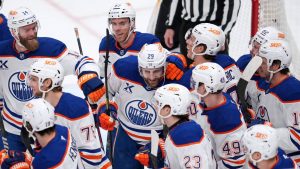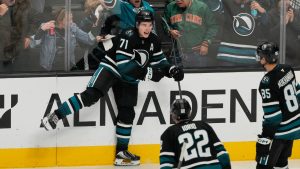WINNIPEG — With the transaction wire slowing to a trickle and still no news on when players around the NHL might be reporting to training camp, it’s no surprise that folks are getting restless.
Such is life for a fanbase whose team hasn’t played since early August, let alone those who haven’t suited up for meaningful game action since March.
So when the call went out for questions surrounding the Winnipeg Jets, the responses were filled with queries about the future of Patrik Laine.
The Finnish forward’s name has dominated the headlines and rumour mill this off-season, with speculation accelerating that Laine and the Jets are more likely headed for a divorce than an extension.
But we’ll get back to that in a moment.
With some additional time myself, there’s a working theory I just can’t shake when it comes to a possible landing spot for Laine.
[snippet id=4167285]
Don’t get me wrong, the best outcome for the Jets is to retain the services of Laine, who has put in the work to round out his game and is still just scratching the surface when it comes to his long-range potential.
This is a guy who is just two years removed from notching five goals in a single game against the St. Louis Blues.
With 138 goals and 247 points in 305 NHL games, Laine has been a consistent point producer and he’s tied for seventh in the NHL in goals since entering the league in 2016.
That’s elite company, which is part of the reason a deal for Laine is complicated — especially so during uncertain economic times in a pandemic. It’s part of the reason I continue to believe that if Laine is eventually moved, there’s no rush for it to be prior to — or even during — the coming season.
Laine remains under contract ($6.75 million cap hit and $7.5 million salary) for one more season and under team control for two more after that, though the player has arbitration rights.
Since he’ll be looking for a raise on a long-term deal, not a lot of teams have either the salary cap room or are willing to deliver the type of return package required for a player of Laine’s calibre.
Which brings me to the Seattle Kraken.
The 32nd franchise will be entering the NHL during challenging times, but one of the things the Vegas Golden Knights have taught us since arriving on the scene is that early success can be possible through shrewd moves leading up to the expansion draft and most certainly beyond.
Of course, the 30 teams participating in the expansion draft next summer (Vegas is exempt) are hoping they learned a few lessons of their own, but the Kraken have the benefit of not being weighed down by salary-cap concerns like most other clubs.
Kraken GM Ron Francis is a patient individual, though there could be some temptation to bring someone like Laine into the fold to be a star the organization can build around.
Laine has global appeal and a great personality to go with his talents.
This isn’t to suggest that’s a route the franchise is set on taking, but one would suspect it’s something that’s at least worth discussing or debating for Seattle.
Of course the price of acquisition remains challenging when thinking of a team that has no players on its current roster and will be looking to add draft picks rather than consider trading some of them in a prospective deal with the Jets.
But it’s food for thought to get the week started.
On to your questions:
As Jets fans, I think a lot of us are stressed about rumours of a Laine trade…why doesn’t Kevin Cheveldayoff come out and address the situation or squash these rumours if it’s not true?
— Dom Zappia
Speculation isn’t going to go away as it relates to Laine or any other player.
It’s part of the fabric in most hockey markets — especially those in Canada.
Last summer, Nikolaj Ehlers went through something similar. He handled things well and came back and had an outstanding season.
Since the Jets returned in 2011, Cheveldayoff has taken a consistent approach in dealing with the rumour mill and that approach often extends to how he handles contract negotiations publicly.
On almost every occasion, Cheveldayoff prefers to avoid engaging in speculative topics and his policy regarding contract negotiations is usually to not say anything at all.
When it comes to Laine specifically, there is an argument to be made for pouring cold water on the trade rumours.
But not doing so doesn’t make a deal any more — or less — likely.
The situation is a complex one.
Laine hasn’t spoken to the local media since August and didn’t do a year-end availability after he was injured in the first game of the qualifying round series with the Calgary Flames.
It seems clear there are some unresolved issues to sort through, but there’s no concrete evidence the Jets and Laine have reached the point of no return and that a trade is inevitable or close to coming to fruition.
As for how Cheveldayoff has handled the queries about Laine’s situation, don’t expect him to change course even if there is a new development to comment on.
With the Jets having to, potentially, extend Laine to a long-term, big-money contract and most of the core already locked in, how do you see the Jets improving the lineup going forward long term outside of draft & develop? It would seem the piggy bank will be close to empty for a while.
— Brent Bernas
A drop in incoming revenue is going to be a harsh reality for all NHL teams to sort through for the foreseeable future.
The Laine situation is going to either be resolved by a new contract or a trade next off-season and having the bulk of the core group should be seen as a benefit for the Jets.
Having prospects become NHL regulars on either entry-level deals or contracts in the $1 million range is going to be critical for the Jets and yes, the draft and development side of things is going to be part of the foundation of the organization.
Internal improvement is expected for some players already on the roster, but in order to return to contender status the Jets are going to need to find players on value contracts to round out the roster around that core group — especially with a Seattle expansion draft looming.
What will the Jets’ first powerplay look like next season?
— Craig Zamzow
This is a subject Sportsnet colleague Sean Reynolds and I discussed recently and the answer isn’t fully known right now, though Jets head coach Paul Maurice has a few more options at his disposal than he did last season.
The Jets’ play with the man-advantage slipped to the middle of the pack last season after being in the top five (fifth and fourth) during the two before that one.
Getting back into the top-five without Dustin Byfuglien manning the point is going to be a challenge, but plenty of offensive weaponry remains and the structure — with captain Blake Wheeler the facilitator along the right-wing boards and Laine and Mark Scheifele as the primary triggermen — has generated plenty of success.
Those roles aren’t expected to change on the powerplay.
The Jets prefer to use a right-handed shot at the top and Neal Pionk, like Byfuglien and Jacob Trouba, supplies that.
In his first season with the Jets, Pionk produced a team-high 25 points with the man-advantage, which is an impressive number. He gets his shot through, but one of the issues for the Jets last season was that Laine’s powerplay production dipped dramatically (from 15 to eight goals) and the one-timer pass from Pionk wasn’t always as crisp as it needed to be.
Can that be improved over time? Absolutely. If the Jets are looking for an alternative, Josh Morrissey could be used in the role.
But what does the arrival of Paul Stastny mean for the powerplay?
[snippet id=3816507]
At the very least, it should provide a boost for the second group. Stastny could also return to his spot down low with the first unit, where he’s very comfortable and his vision and passing ability could come in handy.
However, if that’s the case then Kyle Connor could be bumped to the second unit.
Moving a team’s leading goal-scorer off the No. 1 powerplay isn’t a common occurrence and the only way I see it happening is if the Jets prefer to play him on the half wall. Connor had great success in that spot as a freshman at the University of Michigan and did see some brief time there last season when Maurice mixed things up on the powerplay.
The other consideration for Maurice revolves around whether to include Ehlers on the first unit or to at least find a way for the second unit to get a little more ice time. Ehlers’ ability to enter the zone with speed is one of the assets the Jets will be looking to utilize, no matter which unit he’s on.
Improving on special teams will be a priority this season and the deployment of the personnel is going to be one of the things under the microscope once training camp opens.
But it’s far more likely the Jets will be looking at tweaks on the powerplay than a complete overhaul.
It’s okay to be predictable when you have multiple dangerous options at your disposal.
Do you think Maurice should move Lowry down in the lineup to strengthen the fourth line so that he can play the fourth line more? I feel that the whole team would benefit from Mark Scheifele and Blake Wheeler playing a little less so they are fresher. Plus, the feeling amongst the whole group that they are a team not just a team that relies on one line.
— Lee Davis
The deployment of players and allotment of ice time is going to be a fascinating subject in a season that figures to have a compressed schedule and likely includes a substantial number of games on consecutive days.
One of the issues Maurice has dealt with during his tenure with the Jets is finding a fourth line he can rely on to play somewhere in the neighbourhood of eight-to-10 minutes per night.
That’s something I expect to change this season, whether that involves David Gustafsson carving out a full-time role for himself or Nate Thompson handling the job or moving to the wing remains to be seen.
Moving Adam Lowry down onto that unit — like Maurice did with Andrew Copp a few years back — is not something that is likely to be on the agenda.
Lowry and Copp make up two-thirds of what has been a highly-effective line for the Jets, one that often plays a checking role but spends ample time in the offensive zone. Yes, Lowry’s production dipped last season but my contention is that had more to do with the injuries he dealt with than a drop-off that could continue.
When it comes to finding the sweet spot of ice time for front-line players, that’s also going to be interesting to monitor.
Striking a balance that leads to optimal usage is going to be essential for the Jets to be in the playoff hunt.
It’s been mentioned that there are a few owners who’d rather not play this season due to the losses they’ll incur with little or no revenues from home games. Would you think that the Jets owners might be part of that group?
— Charles Rubin
Although the impact on the bottom line for the Jets has already been and is going to continue to be substantial, I don’t think their ownership group would prefer not to play this season, no.
Not playing this season would have far-reaching economic ramifications for the league, the players and the owners.
That’s why the expectation is that everyone will come together over the next several weeks to formulate a game plan that works for everyone.
[relatedlinks]




